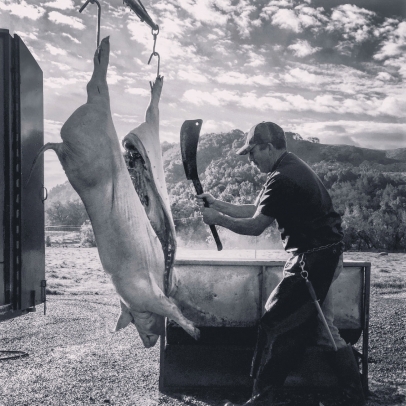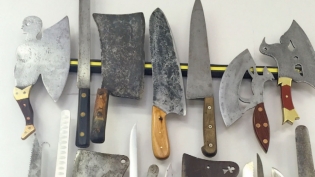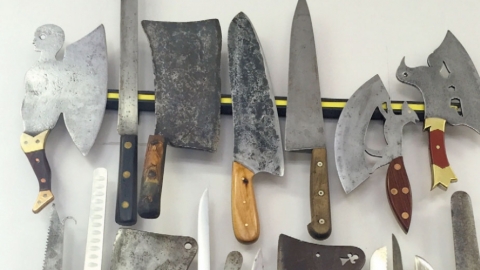Not a Morsel would be Wasted
FOR THE HOG KILLING
Let them stand still for the bullet, and stare the shooter in the eye, let them die while the sound of the shot is in the air, let them die as they fall, let the jugular blood spring hot to the knife, let its freshet be full, let this day begin again the change of hogs into people, not the other way around, for today we celebrate again our lives’ wedding with the world, for by our hunger, by this provisioning, we renew the bond.
—WENDELL BERRY AMERICAN NOVELIST, POET, ENVIRONMENTAL ACTIVIST, CULTURAL CRITIC AND FARMER (B. 1934)
A hair before sunrise found me shivering in the heavy, damp cold of early morning at Hudson Ranch and Vineyards in the Carneros region of Napa Valley. Aromas of soaked earth, dank manure and the tang of blood and mineral fill the nose, awakening the senses to the reality of farm life.
The team at Hudson produces highly acclaimed wines, as well as blue ribbon fruits and vegetables. The ranch also pasture-raises St. Croix Hair Sheep, a rare heritage breed brought to the U.S. in 1996 from the Caribbean. The meat of these sheep is exceptionally delicious, and has graced our table on several occasions. It is, however, the heritage breeds of pigs raised at Hudson that inspire me into the kitchen.
In addition to being fed a high-quality diet of corn, soy, wheat and barley, the Berkshire, Duroc and Old Spotted pigs at Hudson are allowed to roam the extensive hills of the ranch, foraging for roots, grubs and acorns. It is this ranging that lends the meat a succulence and aroma that can only be described as terroir. It’s not hard to understand why Hudson Ranch’s heritage hogs are featured on some of the finest menus in Northern California.
But you better believe that not one of these thoughts was swirling around my agitated brain that morning.
Every year for a decade or more, a pig has been slaughtered, butchered and stocked in my freezer. And on each of these early mornings devoted to the pig’s slaughter, I shiver with the chill of ambivalence. The shot always startles me; forcing me to quickly re-evaluate my honest gut reaction to a living creature’s death for my sustenance. Whether on the ocean, in a field or forest or on a farm, never can I eat on the same day what I took for the pot, the stink of death on my hands needing at least a day to resolve profound remorse into joyful gratitude.
One-Shot John (aka John Taylor of JT’s Custom Slaughter), is a master of his craft . His mobile slaughter unit, a truck servicing small farms and ranches throughout Northern California, is one of the last of its kind in the region. True to his humane sobriquet, he laid to rest the 216- pound pig, a mix of Berkshire, Duroc and Red Wattle, quickly, cleanly, humanely and without instilling the terror of transport from her land.
As the rifle’s pop ricocheted through Carneros’ bosomy hills, scattering blackbirds to escort the pig’s energy to the heavens, the now-familiar ache of remorse and gratitude filled my being. With a silent nod, quick dispatch and little fanfare, One-Shot John washed the pig’s gargantuan body in a large tub and shaved her clean, the skin pinkish and glistening. Hoisting her girth over his shoulders, he strung up the beast on an iron gambrel, steam rising from thick haunches now aglow in the first rays of sunrise.
Cursing my decision to wear a sweater instead of one of my many bedraggled sweatshirts, I busied myself collecting the pig’s blood for boudin noir; bagging the heart and kidneys for frying with onions and Recioto della Valpolicella; collecting the slippery primrose-purple liver for a dense pâté with black trumpet mushrooms; and crudely rinsing the endless rope of intestine for sausage stuffed with ground pork, snow white back fat, Romanian Red garlic and fennel seed.
Not a morsel would be wasted.
Before the sun had even shown its warmth to the hills, the pig was hung in Hudson’s walk-in refrigerator, and I departed to prepare for the days of work ahead. Spices were purchased from a tiny specialty shop in Berkeley, its hippie vibe exemplified by the braless chick with dreads who weighed out our peppers, powders and seeds. We ordered sheep casings for our sausages, packed in salt and shipped from upstate New York. Our knives and cleavers were honed on Japanese stones of varying textures, and plywood boards were bleached and laid on top of the marble kitchen island where we’d butcher.
The Chinese were the first to domesticate pigs for food around 4900 B.C., but the Europeans didn’t catch on to the wonders of pork until 1500 B.C. In 160 B.C., Cato the Elder wrote of “salting the hams” in his great work De Agri Cultura (thought to be the oldest surviving work of Latin prose); describing an established practice in Western Europe since the rule of the Gauls in the fifth century B.C. While the wealthy could afford to buy fresh meat every day, the ability to preserve this precious source of nutrition, often obtained through hunting or husbandry, meant survival for most. Ironically, now cured meat platters are de rigueur in better restaurants and dining rooms around the world. We were about to become, once again, participants in these ancient practices.
Both enormous halves of the beast, solidified from two days of hanging in the cold, traveled from farm to table in my butchering partner’s SUV. We started early and finished late, studying porcine butchering charts, and poring over blood-and grease-spattered cookbooks for spice mixtures, weighing out ingredients on an ancient scale.
We listened to bluegrass, drank green tea and smoked hash. But mostly, we butchered; fingers numbed from the frigid meat, we struggled to make out the muscled edges of each cut. Measure twice, cut once. My antique meat saw, with its fine walnut handle, was outvoted in favor of a modern electric version.
Roasts, ribs and loins were vacuum-sealed. Bones, ears, trotters and tails were reserved for stock and soup. Chunks of pork and fat were separated and bagged for making sausage another day. The belly and cheeks were slathered with spices and curing salts to rest for a couple of weeks before being hung to dry, alongside the two thick hind legs. Heartbroken in prior years by mysterious cases of ravaging molds, or from a too-heavy-handed salting, we decided to once again attempt to create the perfect prosciutto-style ham, a year plus in the making.
At the end of the day, my feet hurt and my arms ached. The floor was greasy and flecked with pieces of meat and bone. I glanced down at my bloodied apron and flashed on the thick-necked butchers I’d seen in New York’s Little Italy, who’d step outside for a smoke and to gawk at women on their lunch breaks.
After scouring most of the grime from the kitchen, we wearily sat to enjoy the fruits of our labors. Bitter greens from the garden were wilted with garlic and fresh pork fat. Finger-sized slices of pork loin were fried quickly in a hot pan and dressed with nothing more than flaky salt; a Marilyn Monroe adorned only in Chanel No. 5. The cork was pulled from a 1990 Barolo, its dusty rose and cranberry acid a perfect foil to the richness of the farm-fresh meat.








